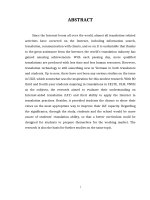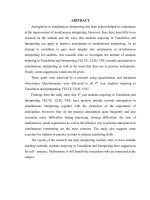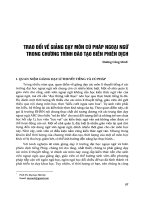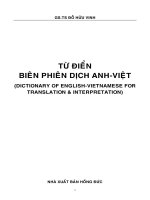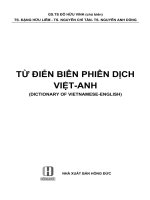GRADUATED PAPER biên phiên dịch
Bạn đang xem bản rút gọn của tài liệu. Xem và tải ngay bản đầy đủ của tài liệu tại đây (418.91 KB, 91 trang )
MINISTRY OF EDUCATION AND TRAINING
DUY TAN UNIVERSITY
DEPARTMENT OF FOREIGN LANGUAGES
GRADUATION PAPER
NGUYEN THI XUYEN
AN ANALYSIS OF THE SUGGESTED
TRANSLATION OF PARTS 3 & 4 FROM THE
2015’S ANNUAL REPORT OF WORLD TOURISM
ORGANIZATION - UNWTO
Code
Course
: K19.701
: 2013 - 2017
DA NANG – May 2017
MINISTRY OF EDUCATION AND TRAINING
DUY TAN UNIVERSITY
DEPARTMENT OF FOREIGN LANGUAGES
GRADUATION PAPER
NGUYEN THI XUYEN
AN ANALYSIS OF THE SUGGESTED
TRANSLATION OF PARTS 3 & 4 FROM THE
2015’S ANNUAL REPORT OF WORLD TOURISM
ORGANIZATION - UNWTO
Code
Course
: K19.701
: 2013 - 2017
SUPERVISOR: M.A. TRAN THI THO
1
ACKNOWLEDGEMENT
In the completion of this graduation paper, I would like to express my special
thanks to my supervisor, the teachers of the Department of Foreign
Languages, my parents, and my friends.
First of all, I would like to express my deepest gratitude to my supervisor,
Tran Thi Tho, M.A, who enthusiastically provides me with useful advice on
every problem, invaluable critical feedbacks and encouragement for
accomplishment of the report. Without her guidance and valuable comments, I
could hardly finish this graduation paper.
Second, I would like to sincerely thank the leadership and the teachers of the
Department of Foreign Languages for providing useful knowledge sources
and directing me during my four academic years.
Finally, I am indebted to my family members and my friends who were
always beside me and supported me during my research completion.
I hope to receive the sympathy from teachers because of the shortcomings in
this graduation.
I wish all of you good health and success!
Yours sincerely!
2
STATEMENT OF AUTHORSHIP
There had not been any published Vietnamese edition of the book containing
the translated chapter until I started working on my graduation paper. My
graduation paper also doesn’t copy any parts of content in other graduation
papers in any universities. It uses information from other chapters in the same
book.
Any source of references is cited and acknowledged in the REFERENCES.
This graduation paper has not been submitted for award of any degree or
diploma in any other tertiary institution.
Danang, May 4th, 2017
NGUYEN THI XUYEN
3
ABSTRACT
This graduation paper is about Tourism field. I translate chapter 3 & 4 (from
English
into
Vietnamese)
named:
“IMPROVING
TOURISM
COMPETITIVENESS & TOURISM –A TOOL FOR SUSTAINABLE
DEVELOPMENT” of the report: “THE 2015'S ANNUAL REPORT OF
WORLD TOURISM ORGANIZATION – UNWTO”. Besides, I also analyze
some necessary issues such as vocabulary and structure in this chapter. In
addition, through this graduation paper, I myself find out some difficulties
that I and other students fell confused in Tourism translation and put forward
some effective solutions.
4
ABBREVIATIONS
SL: source language and
TL: target language
Etc : et cetera
CA/TBD: Châu Á/Thái Bình Dương
P : page
TCDLTG: Tổ chức du lịch thế giới
TTNCKTDLTC: Trung tâm nghiên cứu kinh tế du lịch toàn cầu
GTERC: Global Tourism Economy Research Centre
DMO: Destination Management Organization
NTO: National Tourism Organization
NTA: National Tourism Administration
MCCI: Meetings, Congresses, Conventions and Incentives
TCQLĐĐ: Tổ chức quản lí điểm đến
CTS: Committee on Tourism and Sustainability
UBDLVPTBV: Uỷ ban du lịch và phát triển bền vững
5
TABLE OF CONTENTS
ACKNOWLEDGEMENT.........................................................................................i
STATEMENT OF AUTHORSHIP.........................................................................ii
ABSTRACT...........................................................................................................iii
ABBREVIATIONS.................................................................................................iv
PART A: INTRODUCTION...................................................................................1
1. Rationale.....................................................................................................1
2. Aims and Objectices.................................................................................2
3. Scope of the study.....................................................................................2
3.1
Text Features...................................................................................................... 2
3.2
The Text Length................................................................................................ 3
3.3
The Text Organization.................................................................................... 3
3.4
The Text Source................................................................................................ 3
4. Methodology of the study.......................................................................3
5. Organization of the study.......................................................................4
PART B: DEVELOPMENT....................................................................................5
CHAPTER 1: THEORETICAL BACKGROUND.................................................5
1.1. Translation Theory.................................................................................5
1.1.1. Concepts of translation................................................................................. 5
1.1.2. Rules of translation........................................................................................ 6
1.2. Principles and Methods of Translation.............................................7
1.2.1. Principles........................................................................................................... 7
1.2.2. Methods of Translation................................................................................. 9
CHAPTER 2: SUGGESTED TRANSLATION...................................................13
CHAPTER 3: ANALYSIS.....................................................................................46
3.1. Vocabulary..............................................................................................46
3.1.1. Multi – meaning words...............................................................................46
3.2.2. Specific terms of tourism...........................................................................51
3.2.3. Word compounds with no dictionary equivalences.......................54
3.2. STRUCTURES.........................................................................................57
3.2.1. Complex structures...................................................................................... 57
3.2.2. Structures with passive voice..................................................................64
CHAPTER 4: DIFFICULTIES AND SOLUTIONS............................................68
4.1. Difficulties...............................................................................................68
4.2. Solutions..................................................................................................69
PART C: CONCLUSION AND SUGGESTIONS.................................................71
1. Conclusion..................................................................................................71
2. Suggestions.................................................................................................71
2.1. Implications for Learners.............................................................................71
2.2. Implications for teaching.............................................................................. 72
REFERENCES......................................................................................................74
SUPERVISOR’S COMMENTS
1
PART A: INTRODUCTION
1. Rationale
Along with the development of science and technology, living standards
of people have improved. Tourism needs of people are more and more
increasing. The economy development contributed to create conditions
for tourism development. Since tourism valued and developed, the
tourism competition of the countries in the world has increased fiercely.
Especially, in 2015 tourism continued to be a driver key of the global
economic recovery, and a vital contributor to job creation, poverty
alleviation, environmental protection and multicultural peace and
understanding across the globe. And I chose the report "UNWTO annual
report 2015" of the UNWTO (United Nation World Tourism Organization)
to translate, especially chapter 3 "Improving tourism competitiveness”
and Chapter 4 "Tourism – a tool for sustainable development", it has
showed exactly that.
Tourism has developed around the world. The number of tourists
increases every year. That makes the background motivation for tourism
development of more advanced countries.
Besides, I also would like to introduce this report to Vietnamese readers
and especially the tourists know how tourism in 2015 changed, and also
to help travel companies in the world as well as domestic businesses
understand the situation on the world tourism in 2015.
That is why I chose this text to translate. I hope it can bring good
knowledges for you and all the readers.
Supervisor: Tran Thi Tho
Nguyen Thi Xuyen_1920316267
2
2. Aims and Objectices
In order to support the major aims, some following objectives are
posed for the study:
- To provide readers with a translated version of two chapters of one
of the annual report for countries focusing on tourism.
- To show my ability and skill in translating document as well as in
enhancing my tourism knowledge.
- To analyze difficult words, phrases, or structures which easily
makes misunderstand for readers.
3. Scope of the study
In this graduation paper, I offered a translated version from the
source language in English to the target language in Vietnamese of the
chapter 3 and chapter 4 of the report “UNWTO annual report 2015”. In
addition, I would like to suggest an analysis of the original version as well
as the difficult words, phrases, and structures.
3.1 Text Features
What I translated is an extract from the report “UNWTO annual report
2015” written by United Nation World Tourism Organization
The report shows tourism states on the world, and clearly aims to
show for readers around the world to see the advantages and
disadvantages of tourism this year.
I chose the chapter 3 “Improving tourism competitiveness and Chapter 4
" Tourism – a tool for sustainable development” to translate and analyse.
It is considered two of the best chapters of the report. It is said that how
Supervisor: Tran Thi Tho
Nguyen Thi Xuyen_1920316267
3
to enhance tourism competitiveness in chapter 3 and the sustainable
development of world tourism in 2015 in chapter 4.
3.2The Text Length
The chapters which I chose includes about nearly four thousand five
hundred words in 19 pages. Besides, the language and the level of
difficulty of this text are quite suitable for a fourth-year student.
3.3The Text Organization
The text includes two part :
Part one: Original version
Chapter 3 : “Improving tourism competitiveness”
Chapter 4: " Tourism – a tool for sustainable development”
Part two: Suggested version
3.4The Text Source
“Improving tourism competitiveness” and
" Tourism – a tool for
sustainable development” are the chapter 3 and chapter 4 of the report
“UNWTO annual report 2015” written by United Nation World Tourism
Organization in 2015. This report was originally published in the spring
of 2016 by World Tourism Organization (UNWTO).
4. Methodology of the study
In order to meet the aims, the study used some different methods.
The study begins with qualitative method which helps build the
theoretical background, and list the difficulties through translating.
Besides, I need a lot of time to find out
abbreviated name of
about difficult phrases or
the organizations. Analytic and descriptive
methods, on the other hand, involve in the description troubles in
translating and analysis to find out the best suggestions to have the best
Supervisor: Tran Thi Tho
Nguyen Thi Xuyen_1920316267
4
translated version, based on which generalizations are made as the
findings of the study.
5. Organization of the study
This paper includes three parts:
PART A: Introduction
This part includes rationale; aims and objectives; scope of the
study; text features, text length, text organization, text source; method of
study and organization of the study.
PART B: Development
- Chapter 1 is theoretical background about translation : Introducing
basic translation theory and giving examples for each section.
- Chapter 2 is original version of chapter 3 and chapter 4, which is
followed by my suggested translation.
- Chapter 3 contains the analysis of some typical difficult words,
phrases and structures.
PART C: Difficulties and Solutions
This part shows the difficulties in the process of translation and give
some suggestions to solve the difficulties.
Supervisor: Tran Thi Tho
Nguyen Thi Xuyen_1920316267
5
Supervisor: Tran Thi Tho
Nguyen Thi Xuyen_1920316267
6
PART B: DEVELOPMENT
CHAPTER 1: THEORETICAL BACKGROUND
1.1. Translation Theory
1.1.1. Concepts of translation
There are so many concepts of translation, which are developed by lots of
famous linguists and translators.
According to definition in “A Linguistic Theory of Translation” of J.C.
Catford (1965:20), translation is the replacement of textual material in
one language (source language) by equivalent textual material in another
language (target language).
On the other hand, Pinhhuck (1977:38) in his book, “...translation
is the process of finding a target language (TL) equivalent from a source
language (SL) utterance...”.
Meanwhile, Foster
(1958:1) had different opinion about translation:
“Translation is the act of transferring through which the content of a text
is transferred from the SL into the TL”.
In
“A Textbook of Translation” of Peter Newmark (1988) said that
translation is a craft consisting in the attempt to replace a written
message and/or statements in one language by the same message and/or
statement in another language.
Translation according to Oxford Advanced Leaner’s Dictionary is “[1] the
process of changing something that is written or spoken into another
language [2] a text or word that has been changed from one language into
Supervisor: Tran Thi Tho
Nguyen Thi Xuyen_1920316267
7
another”. These concepts support the idea that translation is a complex
process which requires also theoretical knowledge as well as practical
experiences.
1.1.2. Rules of translation
Based on the document “ Theories of translation” edited and complied by
Mr. Nguyen Manh Quang from Duy Tan University, I mention some rules
which are relevant to all translation to help translators to evaluate their
own work. Besides, I also have some examples from " Luyen dich Viet
Anh" book, edited by authors Minh Thu and Nguyen Hoa to clear the
concepts. Below are some general rules with are relevant to all
translation.
The rule of proximity:
When modifying any item of language, the modifier must be placed
closest to that item even though the modifier is a single word, a phrase or
clause.
As in these examples:
Only David plays piano at the store => Chỉ có David chơi piano ở c ửa hàng.
David only plays piano at the store =>David chỉ chơi piano ở cửa hàng.
The rule of parallelism
The speech element of the same grammatical function must be performed
in an only similar structure form. For example:
He enjoys reading plays and poetry.
She sings and dances beautifully.
Supervisor: Tran Thi Tho
Nguyen Thi Xuyen_1920316267
8
1.2. Principles and Methods of Translation
I also get some examples from Internet source to clear the concepts.
Furthermore, from "A textbook translation" of New Mark, I had some
principle and method of translation as follow:
1.2.1. Principles
1.2.1.1. Meaning
The translation should reflect accurately the meaning of the original text.
Nothing should be arbitrarily added or removed, though occasionally part
of
the meaning can be transposed.
For example: She did it with the reluctance
Cô ấy làm việc với sự miễn cưỡng
1.2.1.2. Form
The ordering of words and ideas in the translation should match the
original as closely as possible.This is particular in the form and order of
words. This is also probably essential in translating legal documents,
guarantees, contracts, etc.). But differences in language structure often
require changes in the form and order of words.
For example: It was for my brother that my father repaired the bicycle.
Đó là vì anh trai tôi mà bố tôi sửa chiếc xe đạp này.
1.2.1.3. Register
Languages often differ greatly in their level of formality in a specific
context. To resolve these differences, the translator must distinguish
Supervisor: Tran Thi Tho
Nguyen Thi Xuyen_1920316267
9
between formal or fixed expressions and personal expressions in which
the writer or speaker sets the tone.
For example: Sorry for being late/ I'm sorry I'm late?
1.2.1.4. Source language influence
Many translations do not sound natural. This is because the translator’s
thoughts and choices of words are too strongly influenced by the original
text. A good way to avoid this is to set the text aside and translate a few
sentences from memory in order to get the natural patterns of thought in
the target language.
For example: The main focus of the Meeting was on policing and law
enforcement in the sphere of child protection in tourism.
=> Trọng tâm chính của H ội ngh ị d ựa trên vi ệc th ực thi chính
sách và pháp luật ở lĩnh vực bảo vệ trẻ em trong du lịch.
1.2.1.5. Idiom
Idiomatic expressions - including similes, metaphors, proverbs, sayings,
jargon, slang, colloquialisms, and phrasal verbs - are commonly hard to
translate.
For example: Đường nào cũng về La Mã
=>All roads lead to Rome
(close equivalents)
1.2.1.6. Style and clarity
The translator should not change the style of the original as much as
possible. Changes are likely to happen if it necessary such as, many
repetitions or mistakes in writing.
Supervisor: Tran Thi Tho
Nguyen Thi Xuyen_1920316267
10
For example: She looked at, pointed her finger hand, and shouted me
during the party.
=> Bà ta vừa nhìn chỉ tay la m ắng tôi su ốt b ữa ti ệc
1.2.2. Methods of Translation
1.2.2.1. Word-for-word translation
This is often demonstrated as interlinear translation, with the TL
immediately below the SL words. The SL word-order is preserved and the
word translated singly by their most common meanings, out of context.
Culture words are translated literally. The main use of word-for-word
translation is either to understand the meaning of the SL or to construct a
difficult text as a pre-translation process.
For example:
Source text: She is deaf to all his advice.
Target text: Cô ta điếc với tất cả những lời khuyên của anh ta.
1.2.2.2. Literal translation
The SL grammatical construction is converted to the nearest TL
equivalents but the lexical words are again translated singly, out of
context. For example:
Source text: This programe is sponsored by Walls.
Target text: Chương trình này do hãng Walls tài trợ.
1.2.2.3. Faithful translation
A faithful translation is used when translators want to reproduce the
precise contextual meaning of the SL within the restriction of the TL
Supervisor: Tran Thi Tho
Nguyen Thi Xuyen_1920316267
11
grammatical structures. It converts cultural words but reserves the
degree of grammatical and lexical “abnormality” in the translation. It
attempts to be completely faithful to the intentions and text-realization of
the SL writer. For example:
Source text: Children shall be pro-tected from abuse and neglect.
Target text: Trẻ em cần được bảo vệ khỏi sự lạm dụng và lơ là.
1.2.2.4. Semantic translation
Semantic translation differs from faithful translation only in as far as it
must take more account of the aesthetic value of the SL text,
compromising on “meaning” appropriate so that no assonance, word-play
or repetition jars in finished version.
For example:
Source text: She has a sunny smile on her face.
Target text: Cô bé có gương mặt với nụ cười tỏa nắng.
1.2.2.5. Adaptation translation
This seems to be the freest form of translation. It is used mainly for plays
and poetry in which the themes, characters and plots are usually
preserved, the SL culture converted to the TL culture and text rewritten
by an established dramatist or poet has produced many poor adaptations
but other adaptation has “rescued” period plays.
For example:
Source text: Thà một phút huy hoàng rồi chợt tắt
Còn hơn bu ồn le lói su ốt trăm năm
Supervisor: Tran Thi Tho
Nguyen Thi Xuyen_1920316267
12
(Xuân Di ệu)
Target text: It would rather the victorious brightness
In an only moment the centenary twinkle
1.2.2.6. Free translation
This reproduces the matter without the manner, or the content without
the form of the original. Usually it is a paraphrase much longer than the
original, a so-called “intralingua translation”, often prolix and pretentious
and not translation at all.
For example:
Source text: The film is beyond any words.
Target text: Bộ phim không chê vào đâu được.
1.2.2.7. Idiomatic translation
Idiomatic translation reproduces the “message” of the original but tends
to distort nuances of meaning by preferring colloquialisms and the idiom
where these do not exists in the original. For example:
Source text: Birds of a feather flock together
Target text: Ngưu tầm ngưu, mã tầm mã
1.2.2.8. Communicative translation
Communicative translation attempts to reader the exact contextual
meaning of the original in such a way that both content and language are
readily acceptable and comprehensible to the readership. For example:
Supervisor: Tran Thi Tho
Nguyen Thi Xuyen_1920316267
13
Source text: Safety. In the United State, the Food and Drug Administration
(FDA) applies strict controls before authorizing the launch of a new drug
on the American market.
Target text:
Sự an toàn. Ở Mỹ, Cục Quản Lý Dược và Thực Phẩm áp
dụng sự kiểm soát nghiêm ngặt trước khi cho phép đưa ra thị trường Mỹ
một sản phẩm dược mới.
Supervisor: Tran Thi Tho
Nguyen Thi Xuyen_1920316267
14
CHAPTER 2: SUGGESTED TRANSLATION
Original version
1. Chapter
Suggested version
3.
Improving
tourism competitiveness
Tourism
destinations
1.
Chương 3. Nâng cao năng
lực cạnh tranh du lịch
and Các điểm đến du lịch cùng
các
enterprises rely on sound and doanh nghiệp dựa vào các phương
dependable tools in order to adapt tiện tốt và đáng tin cậy để thích
and
develop
in
a
rapidly nghi và phát triển trong một thị
transforming global marketplace. In trường toàn cầu biến đổi nhanh
2015, UNWTO provided marketing chóng. Trong năm 2015, Tổ chức
intelligence, statistics and research du lịch thế giới đã cung cấp tiếp thị
on
key
organizing
events
tourism
trends
several
and
while thông minh, những số liệu thống
international kê cùng với nghiên cứu dựa trên
implementing những xu hướng du lịch trọng
cooperation projects with the aim điểm, song song với việc tổ chức
of fostering the competitiveness of một số sự kiện quốc tế và thực
tourism destinations in key areas hiện các dự án hợp tác với mục
such
as
destination đích thúc đẩy sự cạnh tranh của
management,marketing, crisis and các điểm du lịch tại các khu vực
emergency management, quality, quan trọng, như quản lý điểm đến,
and tourism measurement and tiếp thị, quản lý khủng hoảng và
analysis.
tình trạng khẩn cấp, chất lượng ,
cùng với phân tích và đo lường du
Supervisor: Tran Thi Tho
Nguyen Thi Xuyen_1920316267
15
lịch.
2.
Tourism
market
trends
– 2. Những xu hướng trong thị
enhancing tourism competitiveness
trường du lịch - nâng cao cạnh
Marketing intelligence is at the core tranh du lịch
of sound decisionmaking for a more Tiếp thị thông minh là cốt lõi của
competitive tourism sector.
việc ra quyết định đúng đắn về
UNWTO is the leading organization một lĩnh vực du lịch mang tính
that collects and disseminates up- cạnh tranh hơn. Tổ chức du lịch
todate and comprehensive tourism thế giới là tổ chức hàng đầu thu
data, short and long-term forecasts thập và phổ biến dữ liệu du lịch
and knowledge on specific tourism cập nhật và toàn diện, cùng những
segments and source markets.
dự báo ngắn và dài hạn, kiến thức
về những phân khúc du lịch cụ thể
và các thị trường nguồn.
3.
The UNWTO World Tourism 3. Những chỉ số về du lịch của Tổ
Barometer
UNWTO’s
chức du lịch thế giới
flagship
report,
the Báo cáo hàng đầu của Tổ chức du
UNWTO World Tourism Barometer, lịch thế giới , những chỉ số về du
monitors
short-term
tourism lịch của TCDLTG, giám sát các xu
trends throughout the year. Six hướng du lịch ngắn hạn trong suốt
times a year, it provides monthly cả năm. Dựa trên kết quả khảo sát
data
on
international
tourist mới nhất từ ban chuyên gia du lịch
arrivals, receipts and expenditure của TCDLTG, sáu lần một năm, báo
from over 150 countries as well as cáo cung cấp dữ liệu hàng tháng về
prospects for the following months lượng khách du lịch quốc tế, những
Supervisor: Tran Thi Tho
Nguyen Thi Xuyen_1920316267
16
and year, based on the latest survey chứng từ thu, chi của hơn 150 quốc
results of the UNWTO Panel of gia cũng như những triển vọng du
Tourism Experts. In addition, data lịch cho tương lai. Ngoài ra, dữ liệu
on Air Transport Bookings, the về đặt chỗ trong vận tải hàng
Global Hospitality Industry, the không, ngành lưu trú toàn cầu, môi
Economic Environment and the trường kinh tế và các ngành hội
Meetings Industry are available in họp có sẵn được chọn trong tổng
selected editions out of the six in sáu số được xuất bản mỗi năm.
total that are published each year.
4. UNWTO/GTERC Asia Tourism 4. Xu hướng du lịch châu Á của Tổ
Trends
chức du lịch thế giới(TCDLTG)/
Trung tâm nghiên cứu Kinh tế Du
lịch toàn cầu (TTNCKTDLTC).
The second UNWTO/GTERC Annual
Báo cáo thường niên năm 2015 lần
Report 2015 on Asia Tourism thứ
hai
của
TCDLTG/
Trends, published by UNWTO with TTNCKTDLTC về các xu hướng du
the support of the Global Tourism lịch châu Á
được xuất bản bởi
Economy Research Centre (GTERC), TCDLTG với sự hỗ trợ của Trung
was presented at the 4th Global tâm Nghiên cứu Kinh tế Du lịch
Tourism Economy Forum in Macao, Toàn cầu (TTNCKTDLTC) và được
China.
trình bày tại Diễn đàn kinh tế du
lịch toàn cầu lần thứ tư ở Macao,
Trung Quốc.
5.
As a follow up to the 2014 5. Như một sự tiếp nối theo sau
inaugural
report,
Supervisor: Tran Thi Tho
this
second báo cáo khai mạc năm 2014, ấn
Nguyen Thi Xuyen_1920316267
